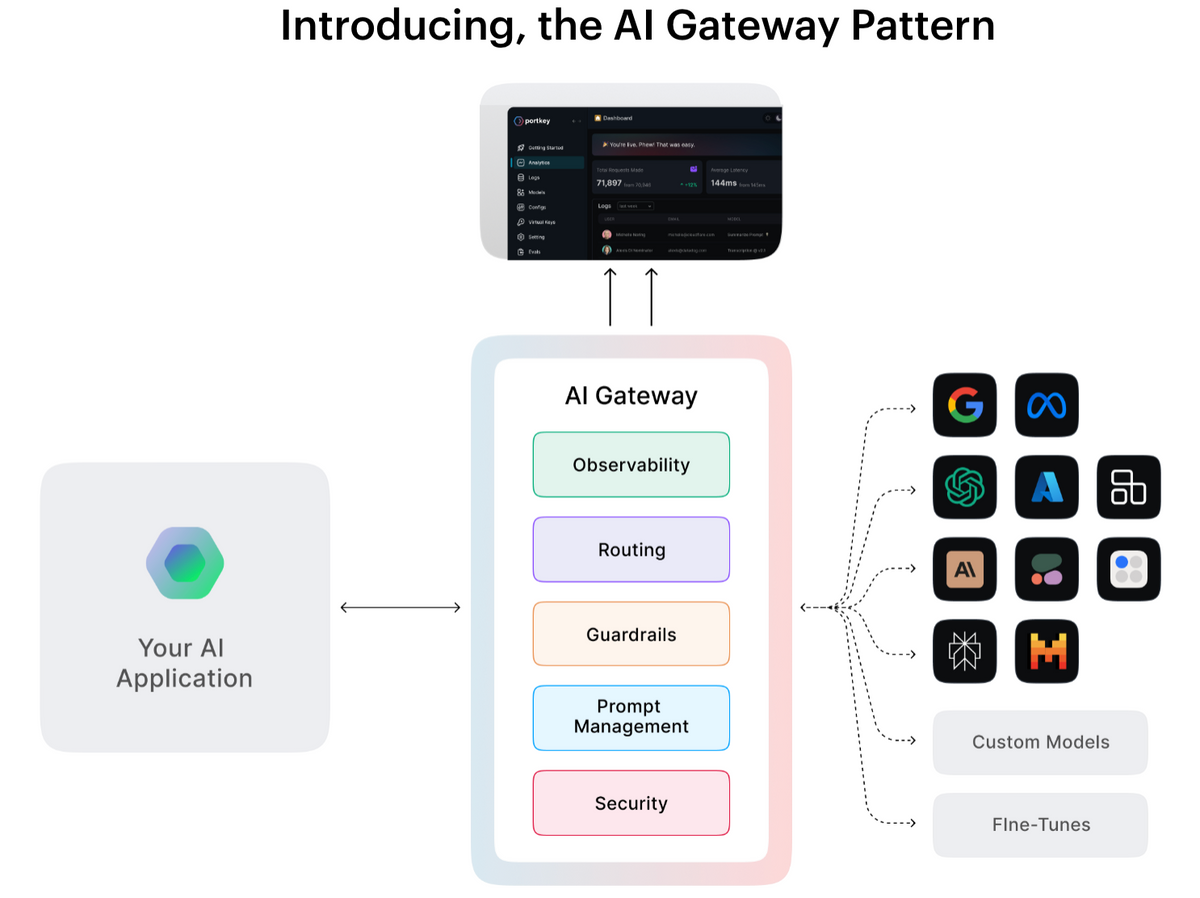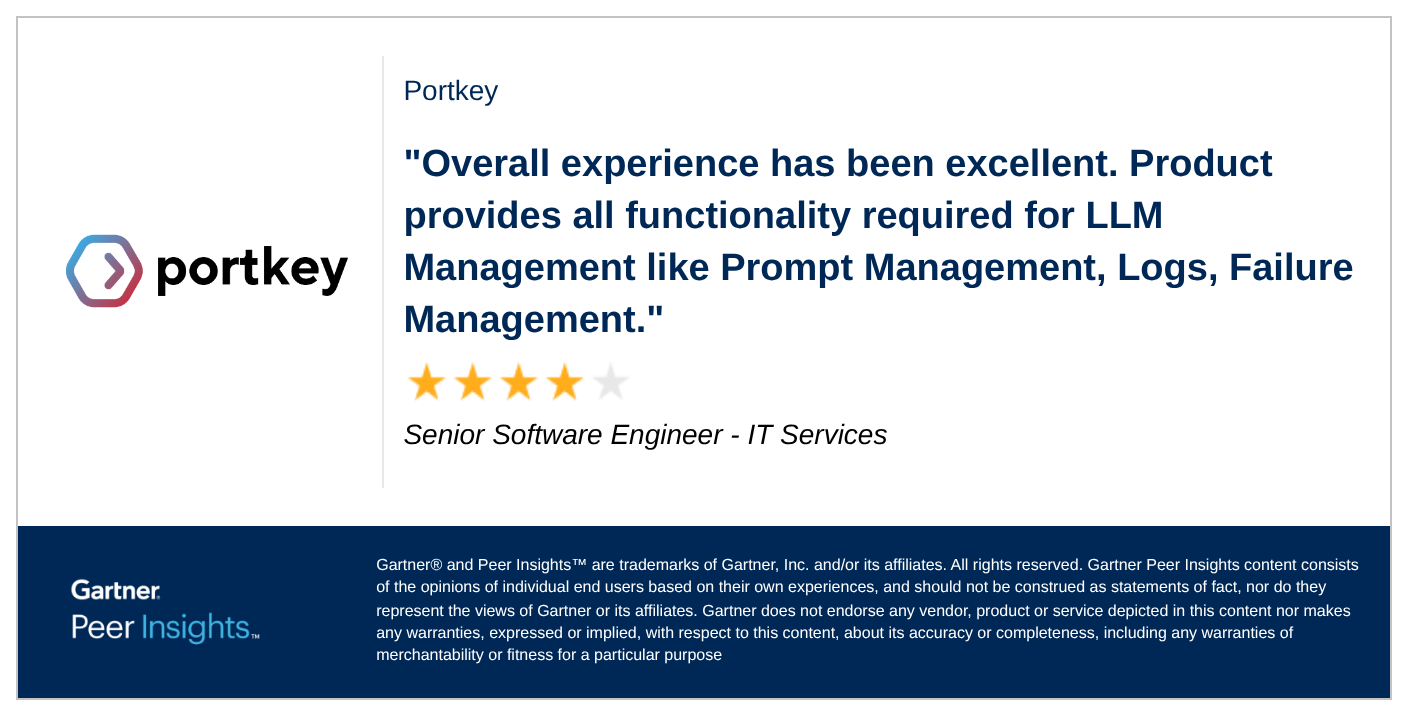What is an LLM Gateway?
An LLM Gateway simplifies managing large language models, enhancing the performance, security, and scalability of real-world AI applications.

LLMs have quietly become the backbone of AI-driven products, powering everything from instant customer support to summarizing terabytes of internal documents. Their ability to handle diverse language tasks accurately has made them essential to many modern AI applications. But behind the scenes, teams are dealing with the complexities of scale, performance, and safety that come with deploying them in the real world.
As businesses look to integrate LLMs into their production environments, they face issues like managing multiple models, ensuring consistent performance, and controlling costs. The complexity increases when dealing with models of different sizes, architectures, and capabilities, making the deployment process difficult to streamline.
This is where the LLM Gateway plays a key role. It acts as a central platform that simplifies and improves the integration, management, and deployment of LLMs. With an LLM Gateway, developers can effectively orchestrate LLM requests, route traffic across different models, and monitor performance in real-time, all from a single point. By handling the operational complexity, the Gateway enables developers to focus on building and scaling AI applications without being held back by technical challenges.
In this blog, we'll explore an LLM Gateway, why it's needed by AI developers, and how it simplifies the process of deploying LLMs at scale.
Why do LLMs need a gateway?
Large language models (LLMs) are powerful tools for generating human-like responses, but using them in real-world applications comes with challenges that can slow down development and increase complexity:

- Different APIs: Every LLM provider has its own API with unique rules, formats, and limits. This makes it harder to connect multiple models to a single application without custom coding for each one.
- Choosing the Right Model: Not all LLMs are good at every task. Picking the best model for a specific job, while keeping costs, speed, and accuracy in mind, can be tricky without an automated system.
- Managing Resources: LLMs use a lot of computing power. Without a way to improve how they are used, teams might spend more money than needed or experience slow performance when demand is high.
- Tracking Performance: Debugging and monitoring models can be tough when they’re spread across multiple systems. Developers need clear tools to track how models are performing, identify errors, and fix issues quickly.
- Ensuring Security: LLMs often handle sensitive information, so it’s important to have safeguards in place to protect data and ensure the outputs meet privacy and compliance standards.
- Scaling for Growth: As usage grows, managing many requests at once and ensuring the system stays fast and reliable becomes a challenge without advanced tools like load balancing and failover.
What is an LLM Gateway?
An LLM Gateway is a centralized orchestration platform that improves the deployment and management of LLMs in production environments. It abstracts the complexities of working directly with individual models, offering a unified interface to connect applications with one or more LLMs.
LLM Gateway solves the above-listed problems by acting as a middle layer between applications and LLMs. It provides a single interface to connect multiple models, set up a failure-proof system, and apply safeguards to protect data and ensure compliance.
It also gives developers tools to monitor performance and improve resource use, making it easier to scale applications. This simplifies working with LLMs, saving time and effort while unlocking their full potential.

By routing requests intelligently and improving both inputs and outputs, an LLM Gateway ensures that applications can use LLMs effectively, securely, and at scale.
Core Functions of an LLM Gateway
- Request Orchestration:
Analyzes incoming queries, normalizes inputs, and routes them to the most suitable model based on parameters like latency, cost, and use case requirements. - Centralized Management:
Provides a single platform to handle API keys, authentication, and model updates, reducing operational complexity. - Performance Optimization:
Implements caching, parallel processing, and cost control mechanisms to enhance efficiency and reduce resource wastage. - Security and Compliance:
Enforces strong data protection protocols and ensures outputs adhere to legal and ethical guidelines. - Monitoring and Observability:
Tracks performance metrics, logs interactions, and provides practical insights to improve application reliability.

How does an LLM Gateway work?
An LLM Gateway is a powerful orchestration layer that manages how applications interact with large language models (LLMs). It simplifies integration, improves performance, and ensures strong security and compliance. Here's a breakdown of how it works, step by step:
1. Request handling
When an application sends a query or task, the LLM Gateway acts as the first point of contact. It parses the input, validates it for completeness and compliance (e.g., ensuring no sensitive data is included), and prepares it for processing. This ensures the system handles only valid and secure data.
2. Conditional routing
The gateway evaluates the incoming request and determines which LLM is best suited for the task. Factors like model capabilities, cost efficiency, latency, and accuracy are considered. For example, you can route a simpler request to a smaller, faster model, while a complex query could be directed to a highly sophisticated LLM. This intelligent routing ensures the best performance and resource use.
3. Real-Time guardrails
As the request is processed, real-time AI guardrails come into play to enforce compliance and ethical standards. These safeguards ensure that the output avoids: - harmful or biased content.
- meets regulatory and organizational requirements (e.g., GDPR, HIPAA).
- aligns with predefined business rules, such as maintaining a specific tone or avoiding sensitive information leakage.
Guardrails can also include tools like filters, PII redaction, or even reinforcement models that adjust outputs on the fly.
4. Integration and transformation
The LLM Gateway provides smooth integration with a lot of tools and apps like Claude Code, Cline, LibreChat, etc.
Once the LLM generates a response, the gateway can format, transform, or augment the output as needed, ensuring it aligns with the application's requirements. For example, adding metadata, adjusting structure, or applying additional processing steps
5. Observability and feedback
Throughout the process, the gateway continuously monitors performance through observability tools. It generates real-time logs, metrics, and analytics to track latency, errors, and resource usage. These insights help with debugging and enable teams to refine configurations, improve routing strategies, or identify underperforming models.
6. Output delivery
Finally, the processed response is delivered back to the application. This smooth flow ensures the application receives high-quality, contextually relevant outputs with minimal latency.
By acting as a unified control hub, an LLM Gateway abstracts away the complexities of managing multiple LLMs, enabling developers to focus on building new AI applications without being bogged down by operational challenges. It's the bridge that connects enterprise-grade AI capabilities with real-world use cases.
Why Portkey’s LLM Gateway stands out
The LLM Gateway is built with a reliable infrastructure capable of handling millions of requests per minute, ensuring smooth performance even under high concurrency. With edge architecture that accommodates sudden traffic spikes, Portkey maintains the best performance without degradation. This reliable infrastructure ensures the gateway can scale dynamically, providing reliability and maintaining a 99.99% uptime, even during high-demand periods.
Key capabilities include:
- Conditional Routing: Intelligent model selection based on cost, latency, and accuracy.
- Failover Mechanism: Distribute AI workloads across models with fallbacks, retries, and load balancing.
- Built-in Guardrails: Customizable safeguards for ethical, regulatory, and organizational compliance.
- Optimization Features: Semantic Caching enhances response times, while Auto-Scaling ensures smooth performance during traffic spikes.
- Observability Tools: Real-time metrics and logs for improved debugging and monitoring.
- Seamless Extensibility: Effortless model and API integrations to future-proof your system.
- Prompt Engineering: Portkey has a full-fledged Prompt Engineering Studio, where users can create, test, version, and deploy the prompts, with minor changes to their code.

Portkey's LLM Gateway allows enterprises to scale AI for diverse use cases with security, adaptability, and best performance.
The future of AI scaling with LLM Gateways
As AI continues to evolve, the demand for scalable, secure, and effective systems will only increase. LLM Gateways are no longer optional—they are essential for unlocking the full potential of LLMs in production. By centralizing orchestration, enhancing performance, and embedding strong security measures, these gateways pave the way for a smooth AI-powered future.
With tools like Portkey's LLM Gateway, developers and organizations can shift their focus from managing infrastructure to driving advanced solutions, allowing smarter, faster, and safer AI applications.
Are you ready to transform your AI workflows? Explore Portkey today and take the next step toward scalable AI solutions.
FAQs
1. Why do I need an LLM Gateway for my AI applications?
LLM Gateway provides a unified interface to interact with multiple models, automates tasks like model selection, improves resource use, and ensures that outputs meet security, ethical, and regulatory standards.
2. Can I integrate new models or APIs into the LLM Gateway easily? Yes! One of the key benefits of Portkey's LLM Gateway is its easy extensibility. It allows you to easily integrate new models and APIs with minimal effort, ensuring your AI system remains adaptable to future needs and advancements.
